(Strand)om Stories: Strikeforce: Morituri (vol. 1) Review
This volume collects the first strong issues of an unsung series wrestling with heroism and death which deserves far more recognition and praise
—by Nathan on October 21, 2025—
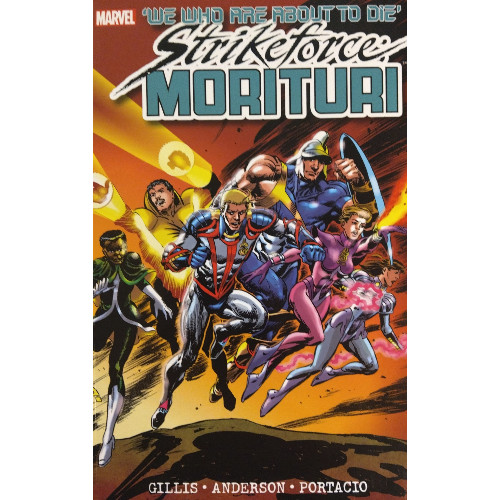
In my review of Shatter, the world's first computer generated graphic novel, I discussed a bit of writer Peter B. Gillis' capable worldbuilding. Though Mike Saenz brought the world of Shatter to life artistically, Gillis provided the story and concepts necessary to make you feel you stepped into a digitized rendition of a future Chicago. In discussing Gillis, I made an offhanded comment about my favorite project of his, a series published with Marvel that I would consider an "off the beaten path" read for those who tend to gravitate towards mainstream superheroes.
Strikeforce: Morituri.
I became aware of the series only a few years ago, and though I can't remember quite where the concept first graced my imagination, I remember feeling compelled to seek it out. The main thrust Gillis gave the series made me wonder just exactly how he executed such an idea. In the world Gillis creates, a future version of Earth (not too dissimilar from the Chicago of Shatter) is under the constant threat of alien bombardment. The bad guys have won! An extraterrestrial force known as "the Horde" has laid siege to our world and constantly attack key locations to plunder resources and stir up fear.
What's an Earth overcome to do?
This is where the Morituri process comes in, an invasive procedure which enables certain compatible individuals to develop all kinds of unique powers…but in the process, affects their metabolism to the point where it limits their lifespans to a year. At most.
A year, at most, to fight the invading Horde.
A year, at most, to make a name for oneself.
A year, at most, to live.
What is life when you're staring down the barrel of that kind of death sentence?
Strikeforce: Morituri (vol. 1)
Writer: Peter B. Gillis
Pencilers: Brent Anderson and Whilce Portacio
Inker: Scott Williams
Colorist: Christine Scheele
Letterers: Jim Novak, Janice Chiang, and Phil Felix
Issues Collected: Strikeforce: Morituri #1-13
Volume Publication Date: January 2012
Issue Publication Dates: December 1986-December 1987
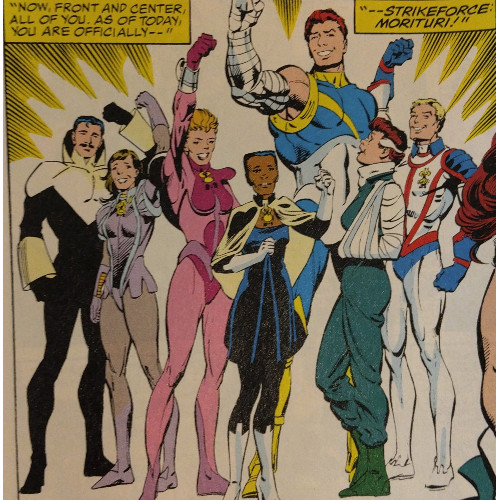
In my Shatter review, I called Strikeforce: Morituri "a genuine hidden gem from Marvel's 80s library." And it is. I've been reading comics for over two decades, and I only heard of this series a few years back. It's not spoken of in the same breath as other memorable Marvel series and runs from the era like Chris Claremont's Uncanny X-Men, David Michelinie's Amazing Spider-Man, Walt Simonson's Thor, or Frank Miller'sDaredevil. Yet it deserves critical analysis and a broader readership. These issues alone are some of the most compelling comics I've read in a while.
I'm a sucker for stories which deal with the intricate interplay between life and death. It's why I love Daytripper, a wonderfully thought-provoking examination of the fragility of life, the suddenness of death, and our responsibility to use our time as wisely as we can. Likewise, Ram V.'s The Many Deaths of Laila Starr approaches the concept from a different angle, a more sympathetic look at death and its integral inclusion in the entire process of living. Strikeforce: Morituri doesn't shy away from similar themes: it's through the lens of their impending deaths–which, theoretically, could happen at any moment from the time our heroes take the Morituri process to a full year afterward–that our shifting cast of protagonists must now view their lives. Limited, yet within those confines, a seeming limitless potential.
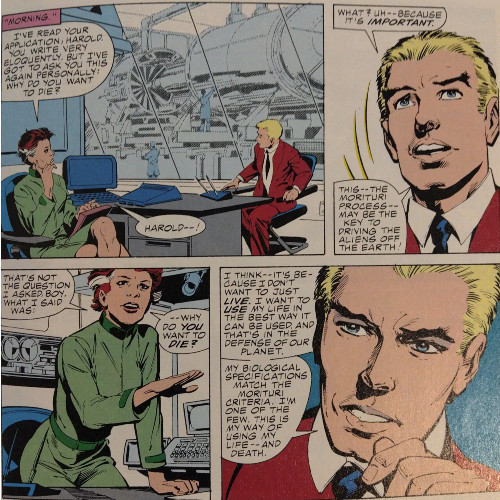
In just these thirteen issues alone, Gillis adequately explores the varying emotions which come from his premise. Our first batch of heroes–Vyking (Harold Everson), Snapdragon (Lorna Maeburn), Marathon (Robert Greenbaum), Adept (Jelene Anderson), Radian (Louis Armanetti), and Blackthorn (Aline Pagrovna)–know the risks they're taking and, soon after they assemble, experience the joys and terrors of their circumstances. Jelene, seeing herself as unwanted and unloved, feels the process will give her life purpose, and she later finds love in the arms of a famous actor. Harold wants to do more for his country than just be a dutiful soldier, his love for the first Morituri heroes, the ill-fated Blackwatch, overriding his fear of death. Robert, with his incredible strength, just wants to rip some Horde aliens apart, take as many of them with him before he expires. Their motivations are multi-faceted and varied, ranging from noble, to patriotic, to less than altruistic, showing you don't have to be a cookie cutter Boy Scout to take the Morituri process.
Each character is imbued with personality traits which make them memorable and relatable, whether it's Adept's faith, Radian's humor, or Marathon's bitterness. They feel like people, stretched beyond a simple overarching characteristic or two, and given traits and motivations as varied as their abilities. It's to Gillis' credit that he makes his ensemble cast work so well individually as they do together, because while watching the Strikeforce together in action is a blast, it's their particularities that make them feel real, which only heightens the hurt when some of them reach the end of their time. "Ah, man, not that guy," I found myself muttering to myself. "Not now." Each death feels unfair, candles blown out while they still had glow to give.
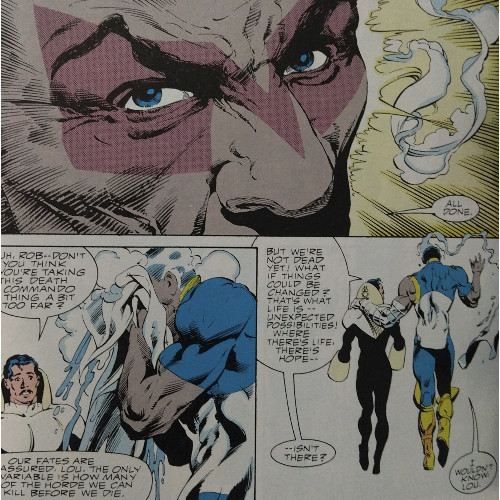
Gillis makes an unspoken promise with the reader: this is not your typical comic book. Dead means dead in this universe, and if you think you can soothe the ache of seeing a Morituri hero explode in a blaze of light or close their eyes one last time by telling yourself they'll be back, you're wrong. In a medium where death feels like a revolving door, Gillis adds weight each time a member is lost. Death could happen at any moment, and often, it occurs in this volume when you least expect it. The idea could become a cheap gimmick in a lesser writer's hands, used always at the least opportune moment to create tension or difficulty for our heroes. And that does happen, on occasion, like when one hero nearly kills the rest of the team by exploding in a spacecraft. But Gillis is both fairly sparing in killing his darlings and random in when they occur, maintaining a level of tension and attention as you flip each page, wondering if this will be the panel, the sequence, the issue where the next Morituri hero is lost…and yet, because they're people and they feel real, you don't want them to die.
What this also means, intriguingly, is that while one Strikeforce team fights the Horde, another is waiting in the wings, training to replace their fallen comrades. The idea is practical, terrifying, and brilliant all at once. Of course you would need a team of heroes to replace the old! Fresh blood! The concept nails the dark side of the Morituri process, more young people willingly sacrificing themselves to provide the greatest good they can in the limited time they have. Fear and hope collide as the process begins anew. In mainstream comics, sure, X-Men die, Avengers die, Justice League members die…but you never see Professor Xavier training a batch of new teenagers because he knows for a fact Cyclops and Marvel Girl and Angel will die within a year. There aren't reserve Justice Leaguers being coached to replace Superman or Wonder Woman out of necessity. But that's the weighty reality Gillis handles in this series, and seeing a new batch of characters, knowing you're currently loving the "old guard" yet realizing the limits they have, just adds to the tension of watching the cycle occur anew.
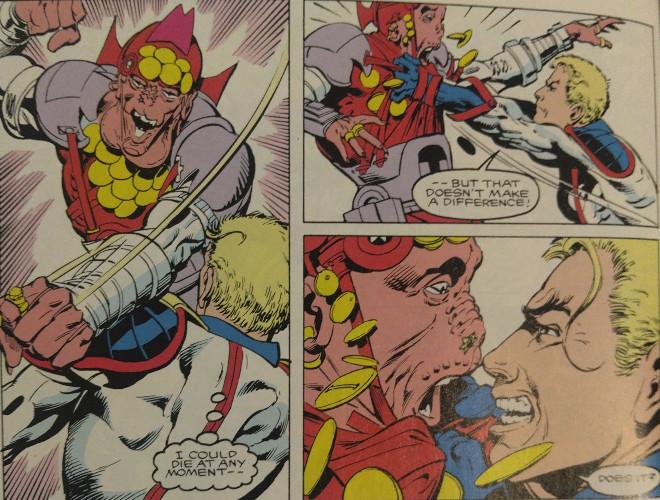
I said "unfair" above, because that's one of the themes present throughout the volume. If Daytripper highlighted the beauty of life through death's presence, Strikeforce: Morituri highlights the brutality. The process is unfair, trading exuberant lives for a fleeting chance at heroism. The alien invasion is unfair, the Horde using weapons culled from another fallen race to bombard Earth, kill people, and assimilate parts of human culture as mere trophies. The military behaves unfairly, in the eyes of our heroes, keeping them cooped up for lengths of time to keep them safe or use their abilities in less vital ways. Gillis dramatizes the horror and the tragedy of this entire situation, dangling a bit of hope at moments to keep you, and our heroes, buoyant.
If I'm making this sound too depressing, it's not my intention. The premise is a starkly tragic one; there is no escaping that. But within the premise are these wonderful moments of humanity–Lorna braids Harold's hair, indicating a level of affection the two may never get to share deeply; the Morituri are given time to revel in their celebrity status, hobnobbing with actors and bigwigs; the heroes stand up for a friend whose full potential they believe is being wasted. They're regular people, drafted into a war, and Gillis does well to develop tension between the Strikeforce and the military organization the team serves. They don't think like soldiers, with plans and schematics. They think like the folks without powers, people just going about their days as normally as they can with an alien fleet hovering in the atmosphere.
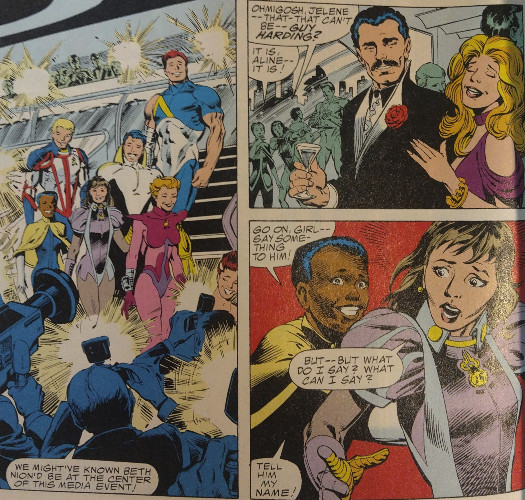
The Horde, as far as villains go, aren't given much of a personality, but they're horrifying abominations to endure. Gillis, similar to how he handled Jack Kirby's Deviants in his Eternals limited series, allows the Horde a culture and some customs, but they otherwise feel fairly homogeneous, at least in this stage of the series. What they lack in individualism, however, they make up for in sheer nastiness. Whether it's assaulting the Earth with invasion forces, throwing hostages from space and watching them burn up on reentry, or deciding to try and nuke Earth cities, the Horde are vicious buggers, and you do really want the Morituri to just rip 'em apart. Their strategy does add some uniqueness–they haven't enslaved the Earth; they're just present, always in a position to strike, always ready to unleash some new horror. This isn't an "aliens are invading" story…the aliens are here. Our heroes are less preoccupied with thwarting an invasion and more focused on removing an occupying force.
These thirteen issues, representing about a third of the full Strikeforce: Morituri series, are an incredibly strong start to a very unique series. I can't think of another book Marvel put out like this. Every so often in the 80s, mainstream comic companies diverged from their bread-and-butter to create some truly unique narratives–check out DC's Camelot 3000 and Hawkworld or Marvel's Squadron Supreme for a few other examples–and this series belongs in that same category. The premise toys with themes of life and death, glory and purpose, and a rotating cast keeps the reader invested, and perhaps a little anxious, in seeing what comes next. Genuinely gripping characters, awful adversaries, and the vagaries of the Morituri process make this series well worth checking out. As I said, it's a hidden gem, worthy of more attention and respect. If you're tired of the vicious cycle of death and rebirth you find in Marvel and DC books, if you want something fresh, check out this book. Yeah, sometimes it's "fresh" as in "fresh meat" thrown into the grinder of the Morituri process, but it's also different and exciting, providing a fun alternative to the standard fare you find on spinner racks or in longboxes.